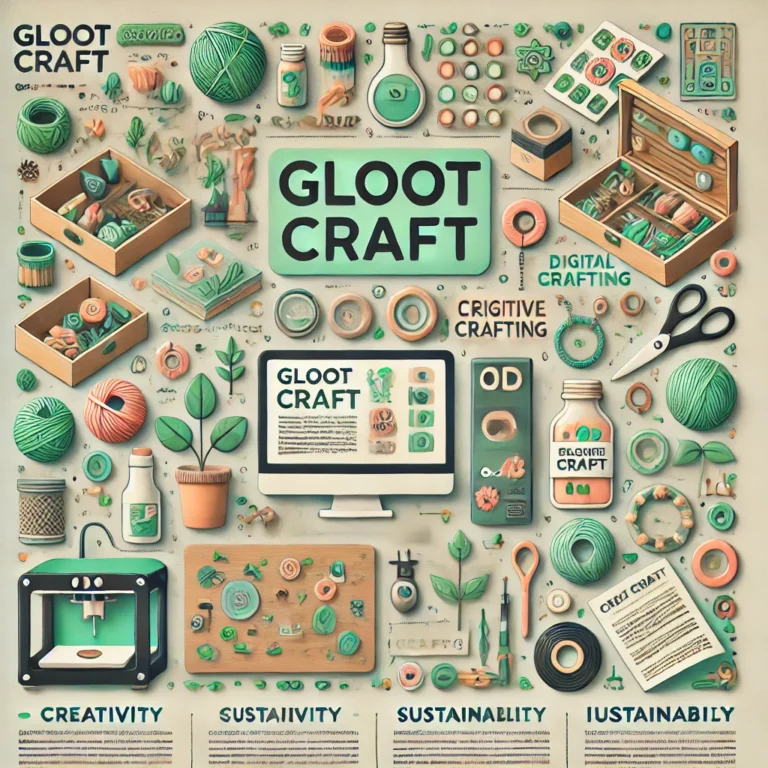In a world increasingly driven by mass production and consumerism, gloot craft emerges as a refreshing countertrend that celebrates creativity, sustainability, and the joy of handmade artistry. Combining traditional crafting methods with modern technologies, gloot craft has quickly become a versatile platform for artisans, educators, and hobbyists alike. This article explores its origins, techniques, environmental impact, and growing popularity, illustrating how gloot craft is reshaping the way we think about crafting.
What is Gloot Craft?
Gloot craft is a unique approach to creativity that merges traditional crafting techniques with innovative technologies. While its origins are rooted in handmade artistry, the practice has evolved to incorporate digital tools such as 3D printing, augmented reality (AR), and AI-driven design. This fusion allows creators to design intricate objects digitally and transform them into tangible, functional, or decorative items.
At its core, gloot craft is about personalization. Whether it’s crafting custom jewelry, home decor, or even prototypes for businesses, the practice empowers individuals to create one-of-a-kind pieces that reflect their creativity and values.
The Origins and Evolution of Gloot Craft
Gloot craft began as a grassroots movement in communities where handcrafted items were a staple of daily life. Over time, the need for sustainability and personalization in a technology-driven world spurred its evolution.
Initially tied to the gaming world, where players could customize in-game items, gloot craft expanded to physical crafting. The integration of advanced tools like laser cutting and AR visualization has made it accessible to creators of all skill levels, bridging the gap between digital innovation and traditional craftsmanship.
Techniques and Materials in Gloot Craft
Traditional Meets Modern
One of the hallmarks of gloot craft is its diverse techniques, which range from classic methods like carving and weaving to modern approaches like 3D modeling and engraving. The practice encourages experimentation, blending traditional skills with new tools for innovative results.
Embracing Sustainability
Gloot craft champions eco-friendly principles by promoting the use of recycled and upcycled materials. Common materials include:
- Wood: Perfect for carvings and functional designs.
- Clay: Ideal for pottery and figurines.
- Fabric Scraps: Used in tapestries, bags, and home decor.
- Metal and Glass: Repurposed into sculptures, jewelry, and vibrant ornaments.
This emphasis on sustainability not only reduces waste but also encourages a culture of resourcefulness.
Why Gloot Craft Matters Today
Supporting Environmental Consciousness
In an era of throwaway culture, gloot craft presents a sustainable alternative. By rethinking how we use discarded materials, it helps reduce environmental impact while fostering creativity. Each project tells a story of transformation, turning “waste” into something valuable and beautiful.
Fostering Creativity and Connection
Gloot craft is more than just an artistic pursuit—it’s a therapeutic activity that nurtures mindfulness and innovation. Crafting by hand allows individuals to slow down, connect with their creativity, and produce meaningful items.
The communal aspect of gloot craft is equally important. Enthusiasts worldwide share their creations and techniques, fostering a sense of community and collaboration.
Applications of Gloot Craft
Personal Projects
For hobbyists, gloot craft offers a creative outlet to explore unique designs. From handmade greeting cards to intricate jewelry, the possibilities are endless.
Education
Schools and universities have incorporated gloot craft into curriculums to teach students design, problem-solving, and sustainability. It serves as a hands-on learning experience that encourages critical thinking and creativity.
Business and Prototyping
Entrepreneurs and small businesses are using gloot craft for product prototyping, custom merchandise, and personalized items. The ability to quickly transform digital designs into physical products is a game-changer for industries aiming to offer bespoke solutions.
The Future of Gloot Craft
As technology advances, the future of gloot craft looks promising. Innovations like virtual reality (VR) are expected to enhance the crafting experience, allowing creators to immerse themselves in their designs before production.
Additionally, gloot craft is likely to play a pivotal role in promoting sustainability. By emphasizing eco-friendly materials and reducing waste, it aligns with the growing global push for environmental responsibility.
Benefits of Gloot Craft
- Uniqueness: Handmade items stand out in a world of mass-produced goods.
- Sustainability: Emphasizes eco-friendly practices and reduces waste.
- Accessibility: With digital tools, anyone can start crafting, regardless of skill level.
- Therapeutic Value: Provides stress relief and a sense of accomplishment.
- Community Support: Encourages collaboration and idea-sharing among crafters.
Getting Started with Gloot Craft
Starting your gloot craft journey is easy and rewarding. Here are some steps to begin:
- Gather Materials: Use what you have at home or visit local thrift stores for inspiration.
- Learn Techniques: Start with simple methods like weaving or carving.
- Experiment: Don’t be afraid to try new tools or mix materials.
- Join Communities: Online forums and local workshops can offer invaluable support and ideas.
FAQs about Gloot Craft
- What materials are commonly used in gloot craft?
Gloot craft emphasizes recycled and eco-friendly materials like wood, clay, fabric scraps, and metal. - Is gloot craft suitable for beginners?
Absolutely! Gloot craft is accessible to all skill levels. Beginners can start with simple projects and gradually explore advanced techniques. - What makes gloot craft different from traditional crafting?
Its integration of modern technologies like 3D printing and AR sets gloot craft apart, offering unique possibilities for personalization and innovation. - Can gloot craft be a sustainable practice?
Yes, gloot craft promotes sustainability by using recycled materials and reducing reliance on mass production. - What are the benefits of practicing gloot craft?
Gloot craft boosts creativity, provides stress relief, supports environmental goals, and fosters a sense of community.
